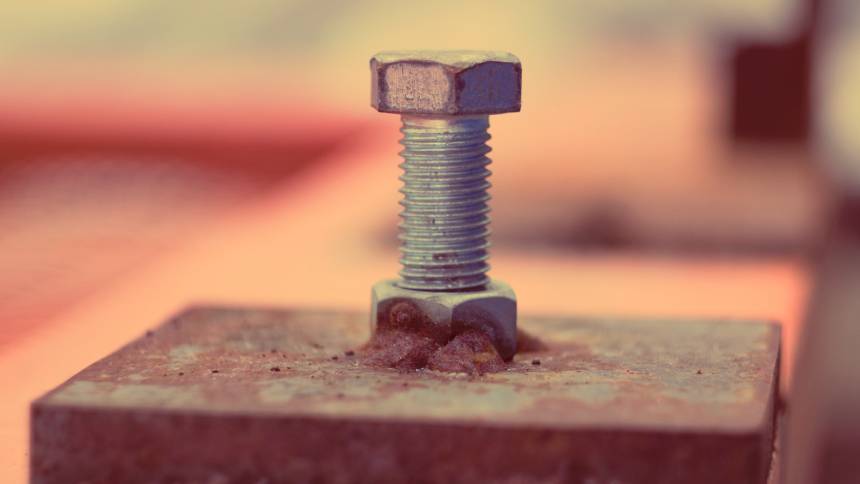If you are serious about strength training and weight lifting, you will start hunting for the best squat rack for your home gym.
Once you have purchased a rack that suits your requirement and cannot wait to start working out, the important question that now comes to your mind is:
Whether or not the squat rack should be bolted down to the floor? The short answer is yes because this will support you with the utmost stability and safety to prevent any mishaps while performing on a squat rack.
I am not against bolting all power racks to the ground, but the problem here is that not every model comes with an option to bolt it to the ground!
Some exercises might cause the power rack to wobble or, worse, even move out of its place sometimes. Such occurrences are extremely unsafe, and it becomes indispensable that you secure them to the ground.

Table of Contents
4 Reasons Why You Should Bolt Down a Squat Rack
There are quite many reasons to secure the squat rack to the floor, and these include:
1. You stop worrying about unintended damages caused by the equipment as bolting the power rack to the floor increases safety and security.
The market is overloaded with aplenty budget-friendly power racks models, each having its own set of specifications, advantages, and disadvantages. A fully-loaded power rack generally weighs between 200 and 500 lbs.
Built with heavy-duty steel and constructed with care to last forever this equipment are strong.
Power racks differ from each other in the features and attachments that they offer. They come in varying sizes depending on the extra provisions and design incorporated.
But if you think that there is one thing that’s common across all good-quality racks, it is none other than their provisioning to secure them to the ground.
Surprisingly, you wouldn’t have noticed until now, but 90% of weight-related equipment offers this provision.
So, if you plan to visit the gym, don’t forget to notice this, and I am sure that you would be pleased with yourself for having found great information—mostly anything that’s not cardio-related is safely bolted to the ground.
How you attach the rack to the ground plays a vital role. Manufacturers always take extra caution to install the necessary detailing and fittings (there are small plates with bolt holes present in every foot of the power rack or any other weight-related fitness equipment) onto every product made.
2. Bolting the rack to the floor helps you work out peace of mind that the equipment stays in place without movement.
We don’t want a rack that suddenly jerks out of place when we are in the middle of weight training, right?
Exercising usually causes a downward force, but not all of it points to the ground.
There is some force that’s exerted laterally, and it’s this lateral force that causes your power rack to move out of place.
There’s no magic spell here, and maybe you have understood this by now.
When you rack the bar hard or load it with more and more weights, it leads to a greater force exerted on the equipment.
To top it all, if you are using the rack with all the weights on it, there are definite chances that it could move.
But that’s not all! You could be attaching bands (which stretch and help you reduce the load on your back) to the top of the power rack, which helps you load more weight, use the bars for calisthenics or simply push/pull while doing stretching using the rack—all of these can induce movement and cause the rack to move out of place.
3. Bolting the rack to the floor guarantees safety.
We exercise to stay fit and become stronger. We don’t want our exercise equipment to be our own devil ruining our exercise routine or, worse, damage our body.
Many individuals don’t mind restoring their ‘out of place’ power rack back into place with a small nudge and hence, don’t take the pain to bolt it to the floor, which could provide a permanent remedy.
But, while performing certain exercises such as kipping pull-ups and scraping the rack press, they exert a lateral force above the center of gravity of the rack.
This poses a dangerous threat as the rack might tip over, and worse, you might be stuck underneath it.
Just imagining the scene where you are lifting an overloaded barbell above your head, and the rack suddenly gives way, tipping over! It’s not soothing to hear. In fact, you don’t want such an occurrence in your life.
Besides the sturdy frame design and high-quality construction that makes a power rack as powerful and capable as it seems, what majorly differentiates racks is the number of accessories attached.
These additions could be as high as possible in the rack, such as pull-up bars and lat pulldown attachments, or could even be placed outside the rack.
Popular accessories that are sought-after by most fitness-loving individuals include dip stations, plus steps, and weight storage.
Any of them can cause the rack to tip over and bring about debilitating results if it is not bolted strongly to the ground.
4. Securing your rack to the floor keeps your kids safe and out of danger.
A home gym is the most attractive play area for your little monkeys who love to explore new stuff.
The attractive colors, different shapes, and the hugeness of certain equipment lure children to try them out irrespective of whether or not they are present in the room.
You might strongly keep your kids under control or even prohibit their entry into the gym room, but not every day is the same.
There could be times when you don’t feel like/can’t controlling them, and this is when your children strike gold—get a free ride into the home gym.
Before you know, they are climbing onto things, cycling on the elliptical, or even lifting dumbbells. The squat rack looks like a monkey ladder, which motivates your little monkeys to climb as quickly as possible onto it, even better when it is a full cage.
Your little hero not only climbs on top of the rack but also swings on it, incrementing the risks of tipping as much as possible.
So, if you have kids in the house, please take extra care and ensure that you secure the power rack to the floor first thing after it’s placed in the room.

The home gym might sound soothing, but any gym is loaded with heavy, huge, and dangerous equipment that might even threaten your kid’s life when they are stuck underneath it.
So, your job doesn’t end with purchasing the best equipment for home gym use that could improve your fitness levels.
It also extends to keeping them safe and secure, protecting every family member against any dangers that might arise due to the equipment’s presence.
How Do You Bolt Down a Squat Rack?
Your decision to bolt down the rack is commendable, although you could call it mandatory in most cases.
Once you are firm about bolting the rack, the major question now that keeps boggling you is how you would bolt down the power rack firmly onto the ground.
How do you bolt down a squat rack? There are two different ways to bolt the rack down—you can secure it to the flooring or secure it onto a lifting platform.
Securing the rack to the floor could be a good choice as you can be sure of no movements or tip-offs, but it causes a permanent hole onto the flooring, which could ruin the look of your room.
If you plan to do it on the floor, you must cut the flooring beneath the rack’s feet to make the equipment sit on the concrete below it.
Make markings on the mounting hole and drill holes into the cement/sub-floor.
Complete the fitting by placing concrete anchors that strongly hold the rack onto the floor.
You could buy an anchor yourself, or you could even buy it from the same company that sells racks, too, as many of them sell concrete anchors as an additional accessory.
To do any of the above, you need the right tools that help you do the job quickly and comfortably.
It is necessary that you have an impact hammer that does the job of bolting the rack into concrete (using anchors) perfectly, without which you can never do it.
But, the other option of securing the rack to a lifting platform is preferred by many as it does not cause any permanent markings or damages to the flooring below.
The lifting platform comprises a couple of layers (3-4) of plywood that’s 3/4″ thick.
It could also be topped with rubber support in places where you might drop the barbell rod with weights on it.
A lifting platform offers several advantages, such as protecting your flooring and weight plates and minimizes noise generated when a heavy barbell is dropped down.
Any lifting platform you buy doesn’t extend under the rack, but it is good to know that many individuals build their own platform, which extends right under the rack.
Such platforms help you mount the power rack on top of it and keep it safe and secure without any problems of tip-offs or falls.
If both the above options are not possible (you might not want to bolt the rack to the floor, or you could not have enough space for a platform), it becomes essential to find a way to load the rack with weights.
Buy weight storage pegs that accommodate heavier plates, which should help you keep the rack in place.
Else, add weights to the rack using a loaded barbell on j hooks.
Buying a rack extension would be better than the other two alternate options mentioned here as it helps you store weights and provides enough space for a spotter inside the rack.
Some manufacturers also design the rack with “flat foot” options that don’t need any bolting down to the floor.
But, if you wish, you can still do it by purchasing bolt-down flanges that are sold as additional accessories.
Power Rack that Doesn’t Require Bolting
If you personally ask my opinion, I would suggest bolting the rack to the floor irrespective of whether it is sturdy or “flat foot” as you are guaranteed additional safety and security.
But customers have indeed found a couple of racks to work perfectly fine without having to bolt them to the floor, the most popular of which is the Body-Solid Pro Power Rack GPR378.
None of them have complained that the power rack suffered from movement issues, or there were situations where it tipped off and fell to the floor while exercising.
Other power racks that have been used by individuals without bolting to the floor include RML 390F, Titan X-3 (flat foot rack), and Body-Solid SPR1000, all of which are loved by users for staying sturdy and heavy even while exercising vigorously.
Rogue power rack with flat foot design (RML 390F) and extreme sturdiness makes it an ideal choice for those who cannot bolt the rack to the floor due to various reasons.
Conclusion
A squat rack is a piece of versatile equipment that occupies a primary role in our everyday exercise routine.
You cannot skip working out or keep avoiding the power rack because you are scared that the rack could trip over and fall or even move away when you workout vigorously.
To avoid any of this and keep yourself safe, it is better to bolt it firmly to the floor or choose any of the above-mentioned options to secure the rack in place.
Take some time and make sure that the rack is safe to use before using the equipment. You will feel happy, peaceful, and safe in due course.
Read Also:
